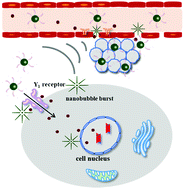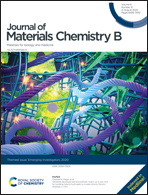Active targeting nano-scale bubbles enhanced ultrasound cavitation chemotherapy in Y1 receptor-overexpressed breast cancer†
Abstract
Ultrasound cavitation therapy has attracted much attention in recent years because the cavitation of microbubbles can be leveraged to boost the infiltration of chemotherapeutic drugs into cancer tissues. For breast cancer therapy, most of the previously reported microbubbles lack specific targeting capacity and permeability. In this study, we have successfully fabricated Y1 receptor ligand (NPY)-modified bubbles, and examined their therapeutic efficacies as size-dependent functions with or without NPY targeting. To achieve this, four types of micro-scale bubbles (MBs or MBs-NPY) and nano-scale bubbles (NBs or NBs-NPY) were comprehensively evaluated. In vivo results indicated that the NBs-NPY group with doxorubicin (DOX) under ultrasound irradiation showed a high tumor suppression effect and a prolonged survival time. Furthermore, the NBs-NPY with DOX group exhibited minimal damage to mouse vital organs, which points to the considerable tolerance of the proposed nanosystem for efficacious breast cancer therapy. In summary, these findings suggest that the developed NPY-targeted NBs could have a broad application prospect in ultrasound cavitation chemotherapy of Y1 receptor-overexpressed breast cancer.

- This article is part of the themed collection: Journal of Materials Chemistry B Emerging Investigators


 Please wait while we load your content...
Please wait while we load your content...